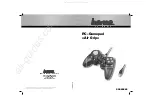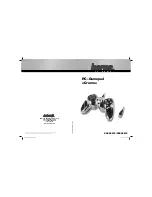
Instruction Manual
D101329X012
1078 Actuator
June 2017
8
Engaging and Disengaging the Manual Actuator
Engaging the Manual Actuator
1. Shut off the supply pressure to the power actuator.
2. Pull the ring on the detent mechanism to unlock the lever. Move the lever into the engaged position until it is
against the stop pin and locked in position by the detent mechanism. (Note that stop pins are not available on 1078
size
II
‐FA actuators.)
3. If applicable, open the power actuator bypass valve.
Disengaging the Manual Actuator
CAUTION
Disengaging the manual actuator when forces such as spring compression, cylinder pressure, and dynamic torque are
present may cause sudden, extreme movement of all control valve components. This can result in damage to equipment
and violent disturbance of the process. Before disengaging the manual actuator, take appropriate steps to ensure that the
return to automatic operation will not result in an extreme repositioning of control valve components. Procedures to
determine approximate system balance are given in the following steps.
1. Before disengaging the manual actuator, approximate system balance should be achieved. The system is in balance
when the actual valve ball or disk position is approximately the same as the position requested by the automatic
control system. Under balanced system conditions, the manual actuator disengaging lever moves freely without
use of excessive force. If after releasing the detent mechanism, the lever does not move freely toward the
disengaged position, some system force is causing an imbalance. A forced return to automatic operation under
these conditions can cause serious damage to the equipment and violent disturbance of the process.
2. If possible, determine whether the automatic control system is tending to open or close the valve ball or disk, and
rotate the handwheel in the appropriate direction until friction in the manual operator is reduced and the lever can
be easily moved by hand. As an alternate approach, local manipulation of the supply pressure to the power actuator
may bring the set point of the automatic system closer to the actual valve ball or disk position.
3. If a smooth transition from manual to automatic operation cannot be ensured, isolate the valve from the process.
Position the manual actuator so that it matches the position of the ball or disk when no supply pressure is applied to
the power actuator.
4. Pull the ring on the detent mechanism to unlock the lever. Push the lever into the disengaged position until it is
against the stop pin and locked in position by the detent mechanism. (Note that stop pins are not available on 1078
size
II
‐FA actuators.)
5. Close the bypass valve and return supply pressure to the power actuator.
Maintenance
If the force required to rotate the handwheel exceeds the wheel‐rim force listed in tables 2, 3, and 4, check for the
following conditions:
D
Insufficient lubrication,
D
Seized actuator parts,






























